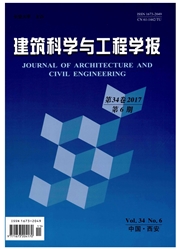

 中文摘要:
中文摘要:
为研究高层建筑转换梁节点上扁柱的抗震性能,进行了3个1:4缩尺模型的低周反复加载试验,对其破坏形态、滞回曲线、极限承载力及延性进行了分析。在试验基础上,利用ABAQUS软件对试件进行了有限元分析;详细讨论了有限元模型的建立、模型材料参数的定义以及斜向钢筋的影响。结果表明:轴压的增大提高了试件的极限承载力,同时也减小了构件的延性;构件荷载一位移滞回曲线饱满,具有较好的耗能能力;在相关参数合理设置的前提下,ABAQUS混凝土损伤塑性模型可用于钢筋混凝土构件的滞回分析;斜向钢筋增加了试件的极限承载力,但位移延性没有明显变化。
 英文摘要:
英文摘要:
In order to study the seismic performance of flat columns on skew girder joint in transfer story of a high-rise building, three low reversed cyclic loading tests on 1 : 4 high- strength concrete flat columns were conducted. The failure pattern, hysteresis curve, ultimate bearing capacity and ductility were analyzed. Based on the experiment, the finite element analysis software ABAQUS was used to analyze the specimens. The establishment of the finite element model, definition of the material parameter and the influences of diagonal reinforcements were discussed in detail. The results show that the ultimate bearing capacity of specimens will be higher with vertical force increasing while the ductility will be decreasing, the load-displacement hysteretic curves are in plump-shape, and the flat columns have excellent seismic behavior. In condition of reasonable parameters, ABAQUS concrete damage plasticity model can be well used for hysteretic analysis of reinforced concrete members. Diagonal reinforcements can improve ultimate bearing capacity of specimens, but have no significant effect on the ductility.
 同期刊论文项目
同期刊论文项目
 同项目期刊论文
同项目期刊论文
 期刊信息
期刊信息
